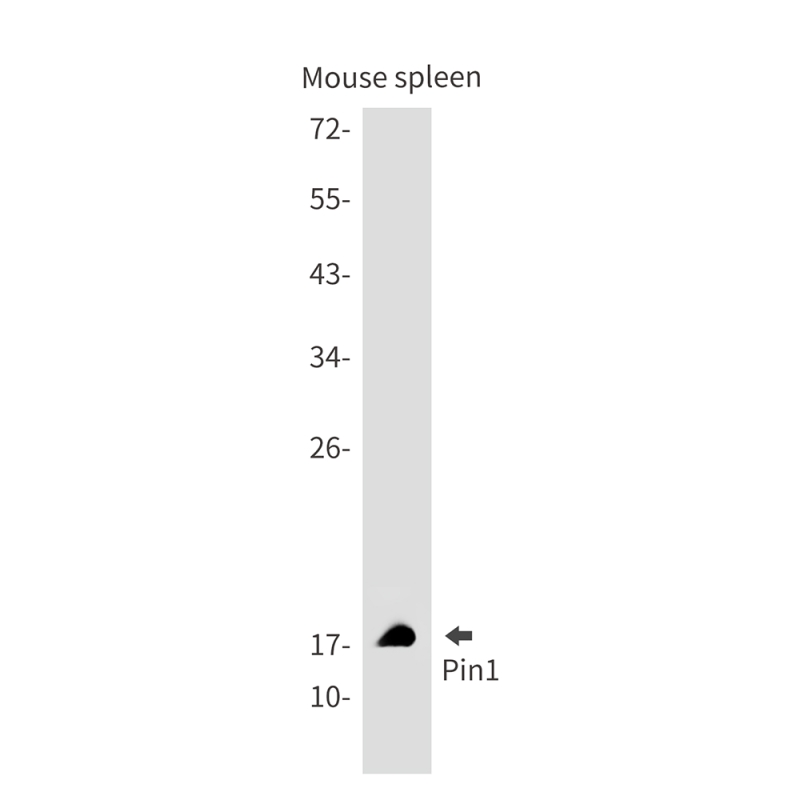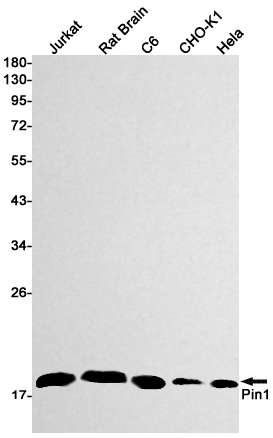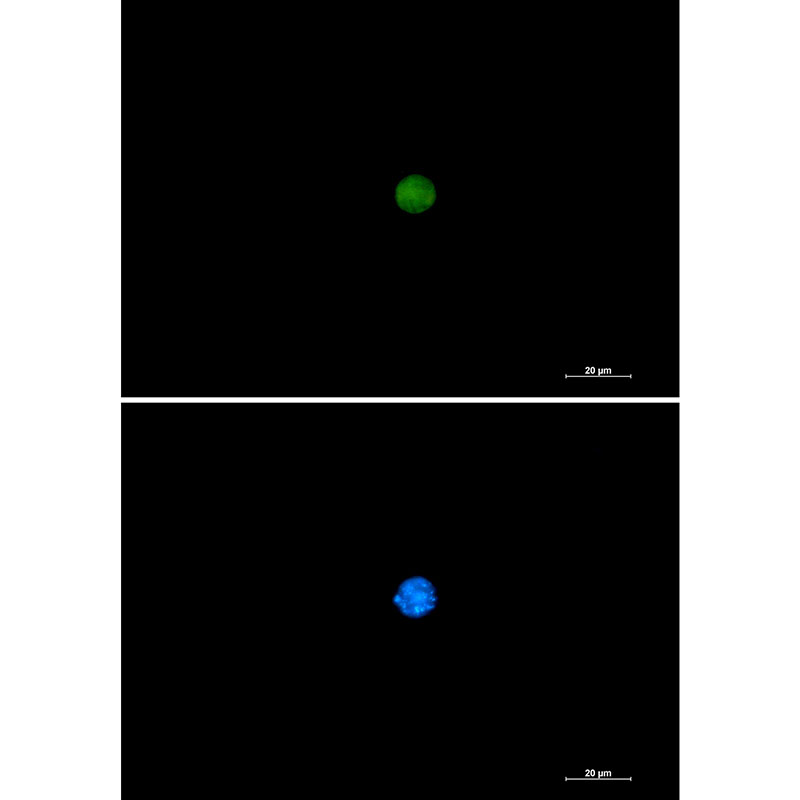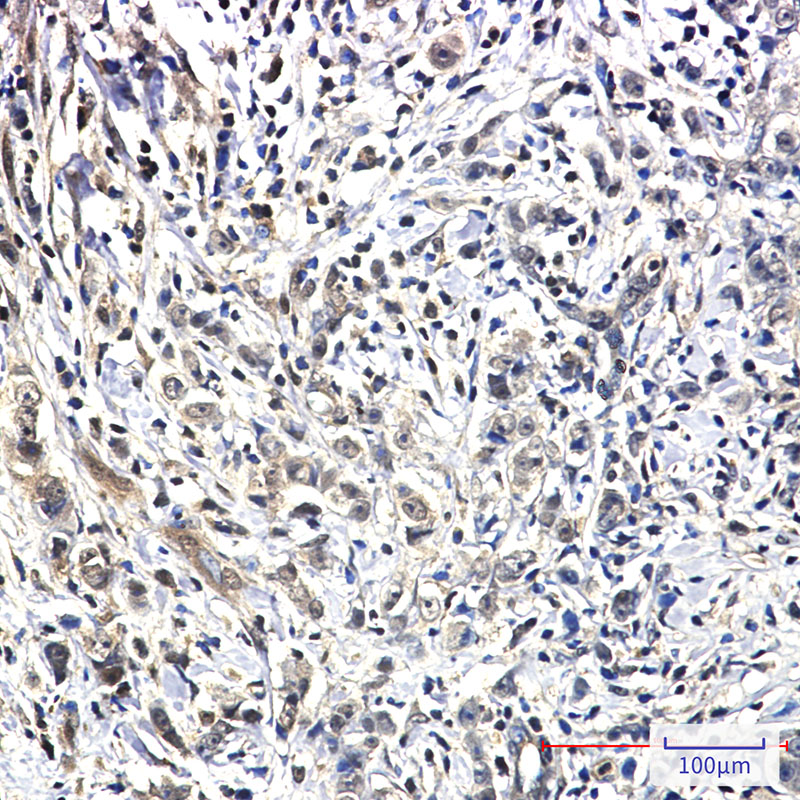



| WB | 1/500-1/1000 | Human,Mouse,Rat,Hamster |
| IF | 1/20 | Human,Mouse,Rat,Hamster |
| IHC | 1/50-1/100 | Human,Mouse,Rat,Hamster |
| ICC | 1/50-1/200 | Human,Mouse,Rat,Hamster |
| FCM | 咨询技术 | Human,Mouse,Rat,Hamster |
| Elisa | 咨询技术 | Human,Mouse,Rat,Hamster |
| Aliases | DOD; UBL5 |
| Entrez GeneID | 5300 |
| WB Predicted band size | Calculated MW: 18 kDa; Observed MW: 18 kDa |
| Host/Isotype | Rabbit IgG |
| Antibody Type | Primary antibody |
| Storage | Store at 4°C short term. Aliquot and store at -20°C long term. Avoid freeze/thaw cycles. |
| Species Reactivity | Human,Mouse,Rat,Hamster |
| Immunogen | Recombinant protein of Pin1 |
| Formulation | Purified antibody in TBS with 0.05% sodium azide,0.05%BSA and 50% glycerol. |
+ +
以下是3篇与PIN1抗体相关的研究文献及其摘要概括:
---
1. **文献名称**:*"The prolyl isomerase PIN1: a pivotal new twist in phosphorylation signalling and disease"*
**作者**:Lu, K.P. et al.
**摘要**:该综述总结了PIN1的结构与功能,强调其在调控磷酸化蛋白构象中的核心作用,并提及多种PIN1特异性抗体在检测癌症及神经退行性疾病中异常表达的实验应用。
---
2. **文献名称**:*"Structural and functional analysis of the mitotic rotamase Pin1 suggests substrate recognition is phosphorylation dependent"*
**作者**:Yaffe, M.B. et al.
**摘要**:研究通过X射线晶体学解析PIN1与磷酸化底物的结合机制,利用抗体验证其在细胞周期调控中的功能,为开发靶向PIN1的小分子抑制剂提供理论支持。
---
3. **文献名称**:*"Antibody-based profiling of Pin1 in Alzheimer's disease and cancer tissues"*
**作者**:Nakamura, Y. et al.
**摘要**:开发了高特异性抗PIN1单克隆抗体,通过免疫组化证实PIN1在阿尔茨海默病脑组织(与tau蛋白磷酸化相关)及多种癌症中的异常表达,提示其作为疾病生物标志物的潜力。
---
4. **文献名称**:*"Prolyl isomerase Pin1 as a molecular target for cancer diagnostics and therapeutics"*
**作者**:Liou, Y.C. et al.
**摘要**:探讨PIN1在肿瘤发生中的作用,并评估抗PIN1抗体在临床样本(如乳腺癌、前列腺癌)中的诊断价值,同时讨论抗体介导的靶向治疗策略。
---
**注**:上述文献标题及内容为示例性概括,实际研究中建议通过PubMed或Web of Science以“PIN1 antibody”为关键词检索最新论文。
**Background of PIN1 Antibody**
PIN1 (Peptidyl-prolyl cis-trans isomerase NIMA-interacting 1) is a highly conserved enzyme belonging to the parvulin family of peptidyl-prolyl isomerases (PPIases). It specifically catalyzes the cis-trans isomerization of phosphorylated serine/threonine-proline (pSer/Thr-Pro) motifs in target proteins, modulating their conformation, stability, and activity. PIN1 plays a critical role in regulating diverse cellular processes, including cell cycle progression, transcriptional regulation, DNA damage response, and apoptosis. Its dysfunction is linked to multiple pathologies, such as cancer, Alzheimer’s disease, and immune disorders, due to its interaction with key signaling molecules like p53. NF-κB, and tau.
PIN1 antibodies are essential tools for studying its expression, localization, and molecular interactions. They are widely used in techniques like Western blotting, immunohistochemistry (IHC), and immunofluorescence (IF) to detect PIN1 levels in tissues or cultured cells. Given PIN1's dual role in promoting oncogenesis and neurodegeneration, these antibodies aid in exploring its mechanistic contributions to diseases and evaluating its potential as a therapeutic target. Commercial PIN1 antibodies are often raised against specific epitopes, such as the N-terminal WW domain or the C-terminal PPIase domain, with validation across species like human, mouse, and rat. Researchers must verify antibody specificity using knockout controls or siRNA-based depletion to avoid off-target effects in experimental models.
×